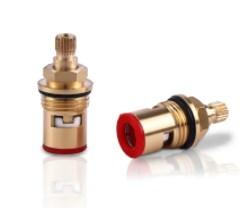Assessing the Wear Resistance of Ceramic Valve Cores in High-Frequency Operation Environments

Ceramic Valve Cores are widely recognized for their exceptional hardness and resistance to corrosion, making them a popular choice in a variety of industrial applications where precision and longevity are key. However, the question of how these components perform under high-frequency use and whether they are prone to wear is a critical consideration for engineers and system designers.
The Ceramic Valve Core, due to its composition, is crafted from advanced ceramics that are known for their hardness and scratch resistance. This material is often selected for applications where metal components might fail due to the abrasive nature of the fluid or the high pressures involved. The high-frequency usage of these valve cores can indeed put them under significant stress, but the wear resistance is superior to many traditional metals, which means that they can withstand a substantial amount of operational cycles without significant wear.
However, the wear on a Ceramic Valve Core is not solely dependent on the material itself but also on the design of the valve and the conditions in which it operates. For instance, if the valve is not properly aligned or if there is debris in the fluid, it can lead to increased wear on the valve core, regardless of the material's inherent durability. Additionally, the pressure and temperature of the fluid, as well as the type of fluid, can all contribute to the rate of wear on the valve core.
To truly assess the wear resistance of Ceramic Valve Cores under high-frequency use, one must consider the quality of manufacturing. A well-manufactured valve core will have tight tolerances and a smooth surface, which can reduce the friction and therefore the wear that occurs during operation. Furthermore, the use of advanced manufacturing techniques can ensure that the ceramic material is uniformly dense and free from microstructural flaws that could act as initiation sites for wear.
Tests and simulations can provide valuable insights into the wear characteristics of Ceramic Valve Cores. These methods can replicate the conditions that the valve core will experience in service, allowing for the observation of wear patterns and the calculation of the expected lifespan of the component. By subjecting the valve cores to cyclic loading and measuring the resulting wear, engineers can determine whether the ceramic valve core is suitable for high-frequency applications.
In conclusion, while Ceramic Valve Cores are known for their resistance to wear, their performance in high-frequency use scenarios is contingent upon several factors, including the quality of the ceramic material, the design of the valve, and the operating conditions. Through rigorous testing and analysis, it is possible to determine the suitability of these valve cores for applications requiring high operational frequency, ensuring that systems remain reliable and efficient over time.
A versatile and efficient plumbing accessory that combines durability, functionality, and user convenience. Designed with precision and crafted from high-quality materials, this washer offers a range of features that make it an essential component in various plumbing applications.
- Art
- Causes
- Crafts
- Dance
- Drinks
- Film
- Fitness
- Food
- Jeux
- Gardening
- Health
- Domicile
- Literature
- Music
- Networking
- Autre
- Party
- Religion
- Shopping
- Sports
- Theater
- Wellness


